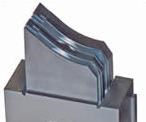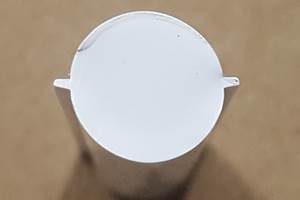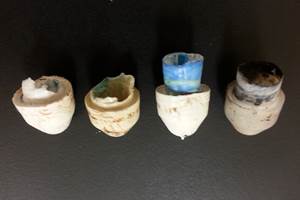Know Your Mold Coatings
Nowadays, there's a lot more to mold wear and corrosion protection than just hard chrome and electroless nickel. Some tools need more protection or more lubricity than they can offer. Here's one expert's guide to the newer options.
A knowledgeable mold buyer today needs to know about more than mold steels. There are also numerous coatings and treatments that can prolong tool life or add performance, such as lubricity for easier resin flow.
Today's plastic materials can be pretty rough on injection molds. Challenges to mold maintenance extend beyond glass- and mineral-fillers to include rice hulls, wood fibers, metal powders, flame retardants, and other additives—not to mention the resins themselves. Aggressive conditions of outgassing and moisture acidity often accompany abrasive wear as potential insults to expensive tooling.
In addition, growing tool complexity involves tinier, more intricate flow passages and more frequent use of moving cores and slides. All these factors have prompted development of a wider variety of mold coatings that can keep molds operating longer between repairs.
Tried and true
Before considering some of the newer, high-tech coatings, it's worth remembering that an old, reliable coating like hard chrome or electroless nickel is sometimes the way to go. One advantage of hard chrome is that it has a hardness of 72 Rockwell C (RC) and is applied at the low temperature of 130 F. When applied in its purest form, it allows you to achieve any SPI finish on your tooling.
Hard chrome is often a good choice for electrical circuit-breaker molds since they use materials containing as much as 40% glass. To help combat erosion and prevent severely damaging gates and surrounding mold areas, we usually recommend a high-diamond polish on a hard-chrome coating of 0.0003 to 0.0005 in.
The downside can be cost, since chrome plating is limited to areas accessible by an anode. If your mold has complex details, it could require an extra conforming anode that adds time and expense to the project. Another possible drawback is chrome's environmental impact—chromium is a carcinogen. Some companies are attempting to develop better, "cleaner" alternatives, but so far we're not aware of anything that matches hard chrome's benefits from a tooling perspective.
Like hard chrome, electroless nickel has been used successfully for years, particularly to protect molds where corrosive off-gassing is created by materials such as PVC or halogenated fire retardants. It is not uncommon to see such resins produce an orange rust, corroding the unprotected mold almost right before your eyes. Products mold ed of such materials for the electronic or medical industry often cannot tolerate the presence of any oxidation byproducts.
| Injection Mold Coatings | ||||||
| Coating | Trade Name | Rockwell Hardness | Coefficient of Friction Against Steel | Applied Temp. | Benefits | Mold Applications |
| Hard Chrome | QQ-C-320a | 72 RC | 0.20 or less | 130 F | Good abrasion resistance. | Glass-filled resins; not for PVC. |
| Electroless Nickel | AMS-2404-Ca AMS-2405-Ba |
50 RC | 0.45 or less | 185 F | Moderate abrasion & excellent corrosion resistance. | Uniform deposit needed; PVC moding. |
| Nickel-Cobalt | NiHarda | 62 RC | 0.24 or less | 185 F | Good abrasion & corosion resistance. | Uniform deposit on complex details; good chrome alternative. |
| Diamond-Chrome | Dia-Clusta | 85+ RC | 0.015 or less | 130 F | Excellent abrasion resistace. | Moving slides, rotating cores, locks. |
| Nickel-PTFE | Nicklona | 45 RC | 0.10 or less | 185 F | Excellent corrosion resistance, high lubricity. | Eases release in deep ribs, no-draft cores, textured surfaces, hard-to-eject resins. |
| Nickel-Boron Nitride | NiBorea | 54-67 RC | 0.05 | 185 F | Excellent lubricity, high wear and corrosion resistance, higher heat resistance than PTFE-based coatings, uniform deposit, easily strippable, no effect on thermal conductivity. | Abrasive resins, unscrewing cores, high-wear parts, fast-cycling molds. |
| Titanium Nitride (TiN) | Balinit Ab | 90 RC | 0.40 | 900-950 F | Abrasion & corrosion resistance, lubricity. | Ejector guides, cores, cavitites, glass-filled resins, PVC |
| aBales Mold Service. bBalzers, Inc. | ||||||
Electroless nickel does an excellent job of resisting oxidation because it plates very uniformly in thin deposits of 0.0002 to 0.0003 in. Even in tight areas of detailed parts, electroless nickel at 50 RC hardness is ideal for corrosion protection. It can be deposited in very accurate thicknesses of 0.002 to 0.003 in. and is easily machined. Thus, electroless nickel is often used for dimensional build-ups under flash chrome and for enlarging threaded cores and inserts or precisely sizing cavities. It also works very well on entire mold bases, A and B plates, ejector-base housings, pin plates, and pillar supports, providing years of low-maintenance, rust-free operation.
New coating science
If you are molding highly intricate parts using glass-filled materials, you might think using hard chrome will be sufficient because it is a classic, reliable way to protect your mold from both corrosion and abrasion. However, hard chrome, for all its benefits, does not tend to plate uniformly in detailed areas like ribs and bosses. There is a newer solution called NiHard, a nickel-cobalt alloy coating that Bales developed to overcome that limitation. As far as we know, there is no other product like it.
Nickel-cobalt can be an economical alternative to hard chrome. Hard chrome requires construction of a conforming anode to coat the mold. The more detail in the mold, the more time it takes to build the anode and the more expensive the process becomes. NiHard requires no anode, and because of its electroless properties, it plates much more uniformly. The cobalt gives it good abrasion resistance, but its hardness is 62 RC, 10 points lower than hard chrome. Is it worth paying extra for hard chrome's superior wear protection? You have to consider the material being run in the mold—what's the percentage of glass? Is corrosion a greater concern than abrasion?
Hard chrome and NiHard offer two very good solutions for abrasion resistance, but for very high-wear conditions, an even newer product called diamond-chrome offers exceptional protection. Developed by Bales, it has an RC rating greater than 85. It is a chromium-matrix composite with a dispersion of nanometer-size, spherical diamond particles. Since diamonds are unmatched for hardness, this coating offers protection beyond the norm. It outperforms titanium nitride coating, though the two have similar Rockwell ratings, because it won't compromise the dimensional integrity of the plated tool. NiHard is applied at only about 130 F. Titanium nitride (TiN) requires application temperatures of 800 F or higher.
Diamond-chrome can plate prehardened, heat-treated, or nitrided steel and other base materials such as aluminum, beryllium-copper, brass, and stainless steel. Recommended uses include cores, cavities, slides, ejector sleeves, and rotating and unscrewing cores. Its anti-galling properties are especially advantageous on moving cores and slides.
Diamond-chrome is also very strippable and has no adverse effect on the base material, saving time and money when maintenance is needed. TiN is strippable as well, but it can take up to several days to remove with a polishing or peroxide-based solution. Diamond-chrome can be stripped in minutes using reverse electrolysis in a caustic solution. In addition, diamond-chrome can be deposited at any controlled thickness from 20 millionths of an inch to 0.001 in. TiN is generally only applied in thin deposits of a few millionths of an inch. Diamond-chrome can coat complex details, while TiN has very limited coverage of complex details. While TiN is very lubricious, with a coefficient of friction of 0.4 (against steel), diamond-chrome has a COF of 0.15—nearly three times more lubricious.
To provide a combination of excellent release properties and high resistance to wear, heat, and corrosion, Bales recently introduced a specialty coating called Nibore. It is an electroless nickel-phosphorus matrix containing boron nitride particles. It has a very low coefficient of friction (0.05 against steel) and an RC hardness of 54, which can be increased to 67 RC after heat treating—a unique characteristic. Nickel-boron nitride can be applied to any substrate at only 185 F and can be easily stripped without compromising the base material. Though more expensive than a nickel-PTFE coating, Nibore performs at up to 1250 F, which far surpasses the 500 F maximum limit for all PTFE-based coatings.
Because applying Nibore is an autocatalytic process, it requires no anode, therefore saving time and money. In addition, Nibore will not compromise thermal conductivity of the mold. Applications include unscrewing cores for closures, where reduced cycle times are essential.
Where very high lubricity is needed for deep ribs, zero-draft cores, textured surfaces and "sticky" polymers, a coating of Bales' Nicklon nickel-PTFE composite will greatly improve part release and enhance resin flow by as much as 4% to 8% for shorter cycle times. Its COF is 0.10 against steel.
It should be noted that applying pure PTFE to the mold adds high lubricity but only a very short-term benefit. PTFE by itself has no hardness, so it won't last. But a dispersion of 25% PTFE by volume in a co-deposit with nickel results in 45 RC hardness for added wear protection.
Know your mold finishes
When it comes to lubricity and release properties, the mold finish must be taken into account as well as the possibility of using a coating. Certain mold finishes may increase the need for a mold coating.
There are four standard SPI finishes: Diamond, Stone, Paper and Blast. Each gives the molding surface a different appearance, from a glossy, mirror-like surface (A-1 Diamond) to a fairly rough, gritty texture (from blasting with glass beads or aluminum oxide). Each of the four finishes has three grades as well.
The A-1 Diamond finish is the most perfect finish available, meaning it has the lowest roughness average or RA value. There are no high or low ridges. For example, a paper scratch on steel can yield a 2 to 4 RA, whereas an A-1 Diamond is lens-quality smoothness, generally 1 RA or less. Roughness is almost immeasurable.
But such perfect smoothness can be detrimental in many molding applications because a number of plastic materials tend to stick like glue to the flawless, mirror-like finish. Molding polystyrene on a polished straight-wall core with 1° or less draft is one example. Streak or drag lines can appear on the parts. This can be solved by flash-chrome plating the core, which creates a surface with micro-cracks. Impregnating those cracks with PTFE and then re-establishing the A-1 Diamond finish solves the problem in more than 95% of cases.
Thin-wall container molding adds another dimension to the use of a Diamond finish. Molders of sour cream, yogurt, and cottage cheese containers find their products are more attractive to the customer if they have a slight sheen. To obtain that effect, these parts require a high-diamond polish with a slightly interrupted gloss adjustment so that the sight sheen will occur. This finish adjustment also allows for much better release of the parts.
In thin-wall molding applications such as these, a light bead-blast finish is applied—just enough to very slightly interrupt the flawless A-2 Diamond surface. The surface is buffed again, leaving just a bit of almost invisible stipple. This finish with a coating of Nicklon nickel-PTFE will greatly improve part release and enhance mold filling.
Phenolics and other thermosets almost de mand a perfect polish and work extraordinarily well with a diamond finish. Combine that with a hard, protective coating like chrome or diamond-chrome, and you will strengthen the mold's surface and optimize release. Again, using a topical PTFE coating would be of minimal benefit because it will not last long. It's usually just not worth it, in our opinion. Successful application of straight PTFE depends on having a sufficient grain structure in the mold finish to hold onto the coating. Since molding thermosets requires a perfect finish on the tool, PTFE by itself will have limited adhesion to the surface and therefore will fail relatively quickly.
Texture & release
If a diamond finish presents release problems, a blast finish can be the answer, particularly when molding textured parts using materials such as silicone rubber, flexible PVC, TPEs, and some soft polypropylenes. These products tend to cling to a polished finish. But breaking up the surface with a light blasting improves release. Add a coating of Nicklon and you get even better release.
We see many textured surfaces today, including faux leather for automobile dashboards, woodgrains, geometric patterns, and stipple patterns such as are found on pagers, cell phones, and computer components. A plated mold coating is often essential to obtaining a textured surface with adequate lubricity.
Textured surfaces require protection. The peaks of the textured surfaces are the first areas of mold detail to experience wear, making it very important to check the mold periodically with a profilometer to measure grain depth and peak counts. Mold coatings help decrease the frequency of repairs and refurbishment by maintaining the integrity of the textured surface.
Hard chrome and electroless nickel plating help protect textured surfaces, as does NiHard, our newer nickel-cobalt coating. Unlike hard chrome, NiHard electroless nickel-cobalt plates uniformly, which is ideal for very detailed molds with deep ribs and bosses. It combines the corrosion protection and lubricity of electroless nickel with the strength of cobalt.
Preventive maintenance
Once you invest in a mold coating to improve tool performance, then a preventive maintenance program is always a good idea to make sure you get the maximum benefit. No coating lasts forever, and you don't want to waste time and money producing substandard parts from a mold with a worn coating. The key is to educate your personnel on how to monitor molds during production. Learn how to tell when the coating is showing deterioration, especially in high-wear areas such as gates and runners.
One of the most important aspects of a preventive program is pulling your mold for maintenance before the coating wears through. Missing important wear signals will mean more costly repairs and additional polishing expense. A hard chrome coating, for example, is approximately 20 RC points harder than the base steel, so exposed steel will wear much faster than the coated surfaces surrounding it, causing deeper holes that require more in-depth repairs.
A thickness gauge is the best way to tell if a coating is wearing through. When the mold first arrives in your plant, take the time to measure the surface thickness, especially in high-wear areas, using this specialized tool. As you run production on the mold, occasionally pause to re-measure those areas. When you have determined that the finish is wearing to a critical level, pull the mold and send it out for maintenance.
Establishing a part-count program is another effective way to determine maintenance needs, especially with high-volume molding projects. From the very first time you run the mold, keep an accurate piece count until it is ready for its first maintenance work. Use that count as a gauge for when the next maintenance is due.
Steven J. Bales is president of Bales Mold Service Inc. in Downers Grove, Ill., which claims to be the largest supplier in North America of specialized coatings for injection molds. Tel: (630) 852-4665
Related Content
Best Methods of Molding Undercuts
Producing plastics parts with undercuts presents distinct challenges for molders.
Read MoreWhere and How to Vent Injection Molds: Part 3
Questioning several “rules of thumb” about venting injection molds.
Read MoreHow to Mount an Injection Mold
Five industry pros with more than 200 years of combined molding experience provide step-by-step best practices on mounting a mold in a horizontal injection molding machine.
Read MoreHow to Start a Hot-Runner Mold That Has No Tip Insulators
Here's a method to assist with efficient dark-to-light color changes on hot-runner systems that are hot-tipped.
Read MoreRead Next
Lead the Conversation, Change the Conversation
Coverage of single-use plastics can be both misleading and demoralizing. Here are 10 tips for changing the perception of the plastics industry at your company and in your community.
Read MoreAdvanced Recycling: Beyond Pyrolysis
Consumer-product brand owners increasingly see advanced chemical recycling as a necessary complement to mechanical recycling if they are to meet ambitious goals for a circular economy in the next decade. Dozens of technology providers are developing new technologies to overcome the limitations of existing pyrolysis methods and to commercialize various alternative approaches to chemical recycling of plastics.
Read MoreProcessor Turns to AI to Help Keep Machines Humming
At captive processor McConkey, a new generation of artificial intelligence models, highlighted by ChatGPT, is helping it wade through the shortage of skilled labor and keep its production lines churning out good parts.
Read More










.png;maxWidth=300;quality=90)





















